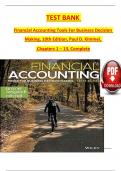TEST BANK
Financial Accounting Tools For Business Decision
Making, 10th Edition, Paul D. Kimmel,
Chapters 1 – 13, Complete
Copyright6©620226John6Wiley6&6Sons,6Inc.6(For6Instructor6Use6Onl
y)
,TABLE OF CONTENTS 6 6
1 Introduction to Financial Statements
6 6 6 6 6
2 A Further Look at Financial Statements
6 6 6 6 6 6 6
3 The Accounting Information System
6 6 6 6 6
4 Accrual Accounting Concepts
6 6 6 6
5 Merchandising Operations and the Multiple-Step Income Statement
6 6 6 6 6 6 6 6
6 Reporting and Analyzing Inventory
6 6 6 6 6
7 Fraud, Internal Control, and Cash
6 6 6 6 6 6
8 Reporting and Analyzing Receivables
6 6 6 6 6
9 Reporting and Analyzing Long-Lived Assets
6 6 6 6 6 6
10 Reporting and Analyzing Liabilities
6 6 6 6 6
11 Reporting and Analyzing Stockholders’ Equity
6 6 6 6 6 6
12 Statement of Cash Flows
6 6 6 6 6
13 Financial Analysis: The Big Picture
6 6 6 6 6 6
Copyright6©620226John6Wiley6&6Sons,6Inc.6(For6Instructor6Use6Onl
y)
,CHAPTER 1 6
INTRODUCTION TO FINANCIAL STATEMENTS
6 6 6
CHAPTER6LEARNING6OBJECTIVES
1. Identify6the6forms6of6business6organization6and6the6uses6of6accounting6information.6A6sole6propriet
orship6is6a6business6owned6by6one6person.6A6partnership6is6a6business6owned6by6two6or6more6people
6associated6as6partners.6A6corporation6is6a6separate6legal6entity6for6which6evidence6of6ownership6is6p
rovided6by6shares6of6stock.6Internal6users6are6managers6who6need6accounting6information6to6plan,6or
ganize,6and6run6business6operations.6The6primary6external6users6are6investors6and6creditors.6Investor
s6(stockholders)6use6accounting6information6to6decide6whether6to6buy,6hold,6or6sell6shares6of6a6comp
any‘s6stock.6Creditors6(suppliers6and6bankers)6use6accounting6information6 to6 assess6the6 risk6 of6 granti
ng6 credit6or6loaning6 money6to6a6business.6Other6groups6who6have6an6indirect6interest6in6a6business6a
re6taxing6authorities,6customers,6labor6unions,6and6 regulatory6agencies.
2. Explain6the6three6principal6types6of6business6activity.6Financing6activities6 involve6collecting6the6nec
essary6funds6to6support6the6business.6Investing6activities6involve6acquiring6the6resources6necessary6t
o6run6the6business.6Operating6activities6involve6putting6 the6resources6of6 the6business6into6action6to6
generate6a6profit.
3. Describe6the6four6financial6statements6and6how6they6are6prepared.6An6income6statement6presents6t
he6revenues6and6expenses6of6a6company6for6a6specific6period6of6time.6A6retained6earnings6statement
6summarizes6the6changes6in6retained6earnings6that6have6occurred6for6a6specific6period6of6time.6A6bal
ance6sheet6reports6the6assets,6liabilities,6and6stockholders‘6equity6of6a6business6at6a6specific6date.6A6s
tatement6of6cash6flows6 summarizes6 information6concerning6the6cash6inflows6(receipts)6and6outflow
s6(payments)6for6a6specific6period6of6time.6Assets6are6resources6owned6by6a6business.6Liabilities6are6t
he6debts6and6obligations6of6the6business.6Liabilities6represent6claims6of6creditors6on6the6assets6of6the
6business.6Stockholders‘6equity6represents6the6claims6of6owners6on6the6assets6of6the6business.6Stockh
olders‘6equity6is6subdivided6into6two6parts:6common6stock6and6retained6earnings.6The6basic6accounti
ng6equation6is6Assets6=6Liabilities6+6Stockholders‘6Equity.6Within6the6annual6report,6the6management
6discussion6and6analysis6provides6management‘s6interpretation6of6the6company‘s6results6and6financial
6position6as6well6as6a6discussion6of6plans6for6the6future.6Notes6to6the6financial6statements6provide6ad
ditional6explanation6or6detail6to6make6the6financial6statements6more6informative.6The6auditor‘s6repo
rt6expresses6an6opinion6as6to6whether6the6financial6statements6present6fairly6the6company‘s6results6o
f6operations6and6financial6position.
*4.6Explain6the6career6opportunities6in6accounting.6Accounting6offers6many6different6jobs6in6fields6such6
as6public6and6private6accounting,6governmental,6and6forensic6accounting.6Accounting6is6a6popular6m
ajor6because6there6are6many6different6types6of6jobs,6with6unlimited6potential6for6career6advancemen
t
Copyright6©620226John6Wiley6&6Sons,6Inc.6(For6Instructor6Use6Onl
y)
, 2-2 Test6Bank6for6Kimmel,6Financial6Accounting:6Tools6for6Business6Decision6Making,610
e
Difficulties:
Easy:6143
Medium:6101
Hard:612
Question6List6by6Section
Business6Organization6and6Accounting6Information6Uses:6For
ms6of6Business6Organization;647,648,6202,6246
Sole6Proprietorship:65,644,649,658,659
Partnership:61,64,646,656
Corporation:62,63,645,650,651,652,653,655,657,6233,6245
Hybrid6Forms6of6Organization:660,661
Users6and6Uses6of6Financial6Information:66,67,611,674,687
Internal6Users:662,663,664,675,677,682,6234
External6Users:68,69,610,612,665,676,678,679,680,681,683,684,685,686,688,689
Data6Analytics:666,667,668,669,670,6235,6236
Ethics6in6Financial6Reporting:671,672,673,6237,62556The6
Three6Types6of6Business6Activity:697
Financing6Activities:613,615,618,690,691,693,694,695,696,697,6102,6109,6117,6118,6119,6238
Investing6Activities:614,616,698,699,6115,6116
Operating6Activities:617,619,620,6100,6101,6103,6104,6105,6106,6107,6108,6110,6111,6112,6113,
114
The6Four6Financial6Statements:
Income6Statement:621,622,623,624,127,6128,6132,6133,6134,6138,6142,6143
Retained6Earnings6Statement:6120,6122,6123,6 124,6125,6126,6129,6130,6131,6135,6137,6139,6140,
141,6144,6145,6146,6147,6148,6149,6150,6154,6164,6169,6178,6181,6252
Balance6Sheet:625,627,628,629,630,631,632,633,634,635,6136,6151,6152,6153,6163,6165,6166,6168,
170,6173,6177,6179,6180,6182,6185,6186,6187,6188,6199,6200,6201,6207,6208,6213,6214,6215,6216,
217,6218,6219,6220,6221,6222,6225,6229,6239,6240,6241,6253
Statement6of6Cash6Flows:626,6121,6171,6174,6183,6242,6249
Interrelationships6of6Statements:6155,6156,6157,6158,6159,6160,6161,6162,6167,6175,6176,6184,
250,6251,6256
Elements6of6an6Annual6Report:636,641,6192,6196,6197
Management6Discussion6and6Analysis:640,6191
Notes6to6the6Financial6Statements:637,642,6190,6193,6194,6198,6254
Auditor‘s6Report:638,639,6195
Copyright6©620226John6Wiley6&6Sons,6Inc.6(For6Instructor6Use6Onl
y)




